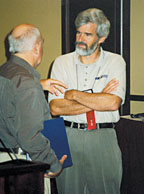“My message in this year’s annual report is that our industry must commit to transforming our business environment,” said HRAI chairman Rick Jones. “Resisting this technology transformation could be catastrophic for the industry and make our businesses less competitive, provide opportunities for new competitors to enter the market, and lessen our ability to meet customers’ changing expectations.”
Jones asserted that HRAI was committed to providing leadership in the areas of new technology and supply chain management. “The challenges facing the hvacr industry are increasing in the regulatory arena and the Canadian marketplace,” he concluded. “I am pleased to report that your association is perfectly positioned to respond to these challenges and assist in transforming the business environment towards a more profitable future.”
Energy Prices, Utilities
Speaker John Todd asked his audience for specific concerns regarding utilities and the energy market. The president of Ecoanalysis Consulting Services, Inc., Toronto, ON, listened as hvacr contractors talked about rising energy prices. Most of the audience seemed to agree that high energy prices provided more opportunities for business rather than more risks.Other contractors were concerned about utilities entering the field of hvacr services. At that point, Todd said, “There is a way to fight back by getting into selling commodities, just like your competitors.”
“The problem with the regulatory market is that it is run by rules and not by the market,” he said. “We actually don’t have deregulation, we have reregulation” — that is, the shifting of one type of commodity selling to another.
Todd maintained that rules don’t drive the market — the market drives the market. Therefore, contractors have to be prepared for fluctuations in demand for their products and services in a deregulated market, and adjust accordingly.
“When the price of energy goes up, you gear up for more demand for high-efficiency equipment,” he added. “But when prices go down, you have to be able to react to less demand.

A Tale of Two Areas
Todd cited two deregulation experiences, one in Alberta, Canada, which has caused confusion and concern, and another in Pennsylvania, which has been a cause for optimism.
Alberta:
“A lot of rules have been set up and then changed by utilities. We have to wonder if deregulation is a swing of the pendulum which will eventually come back, or if it is a permanent change,” Todd said.
Publication date: 09/24/2001



